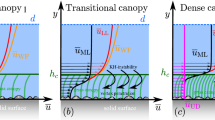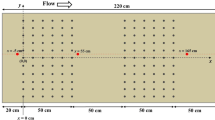Abstract
This paper presents a descriptive analysis of the double layer vegetation flow and the application of different empirical models for velocity distribution in vegetation flow. To establish the models, extensive experiments are carried out using plastic dowels of differential heights, configurations and densities. The previous models based on empiricism and momentum balance are applied here and found to work satisfactorily. However, it is found out that the boundary conditions play a significant role to capture inflection over vegetation level. Furthermore, the most important factor for capturing the inflection above zero plane displacement is to understand the intermediate boundary conditions and their superposition rather than extremum conditions. Therefore a new model for mixing length over the short vegetation height has been suggested. The results from the velocity distributions, turbulence intensity and vorticity of the experimental data are used to derive a new relationship for mixing length under certain assumptions. For establishing the proposed model other researchers’ data are considered and finally corroborated for the validation set, which suggests that the proposed model agrees reasonably well with the measured data.












Similar content being viewed by others
References
Poggi D, Porporato A, Ridolfi L, Albertson JD, Katul GG (2004) The effect of vegetation density on canopy sub-layer turbulence. Bound Lay Meteorol 111(3):565–587
Kouwen N, Unny TE, Hill HM (1969) Flow retardance in vegetated channels. J Hydraul Div ASCE 95(IR2):329–342
Klopstra D, Barneveld HJ, Van Noortwijk JM, Van Velzen EH (1997) Analytical model for hydraulic roughness of submerged vegetation. In: Proceeding of 27th congress of IAHR, theme A, San Francisco, ASCE, pp 775–780
Carollo FG, Ferro V, Termini D (2002) Flow velocity measurements in vegetated channels. J Hydraul Eng 128(7):664–673
Ghisalberti M, Nepf HM (2002) Mixing layers and coherent structures in vegetated aquatic flows. J Geophys Res 107(C2):3-1–3-11
Nepf H, Ghisalberti M, White B, Murphy E (2007) Retention time and dispersion associated with submerged aquatic canopies. Water Resour Res 43:W04422
Yang W, Choi S (2010) A two-layer approach for depth-limited open channel flows with submerged vegetation [J]. J Hydraul Res 48(4):466–475
Katul G, Poggi D, Ridolfi L (2011) A flow resistance model for assessing the impact of vegetation on flood routing mechanics. Water Resour Res 47(8):W08533
Nepf HM (2012) Hydrodynamics of vegetated channels. J Hydraul Res 50(3):262–279
Tang X, Ali S (2013) Evaluation of methods for predicting velocity profiles in open channel flows with submerged rigid vegetation. In: Proceedings of the 35th IAHR world congress, Sept. 8–13, Chengdu, China
Nikora N, Nikora V, O’Donoghue T (2013) Velocity profiles in vegetated open-channel flows: combined effects of multiple mechanisms. J Hydraul Eng 139(10):1021–1032
Huai W, Wang W, Hu Y, Zeng Y, Yang Z (2014) Analytical model of the mean velocity distribution in an open channel with double-layered rigid vegetation. Adv Water Resour 69:106–113
Tang X (2018) Methods for predicting vertical velocity distributions in open channel flows with submerged rigid vegetation. In: Proceedings of 21st IAHR-APD congress, Sept. 2–5, vol 1, pp 567–576. Yogyakarta, Indonesia
Huai W, Hu Y, Zeng Y, Han J (2012) Velocity distribution for open channel flows with suspended vegetation. Adv Water Resour 49:56–61
Tang H, Tian Z, Yan J, Yuan S (2014) Determining drag coefficients and their application in modelling of turbulent flow with submerged vegetation. Adv Water Resour 69:134–145
Tang X (2018) A mixing-length-scale based analytical model for predicting velocity profiles of open channel flows with submerged rigid vegetation. Water Environ J. https://doi.org/10.1111/wej.12434
Liu D, Diplas P, Fairbanks JD, Hodges CC (2008) An experimental study of flow through rigid vegetation. J Geophys Res 113:F04015. https://doi.org/10.1029/2008JF001042
Liu D, Diplas P, Hodges CC, Fairbanks JD (2010) Hydrodynamics of flow through double layer rigid vegetation. Geomorphology 116(3–4):286–296
Raupach MR, Finnigan JJ, Brunet Y (1996) Coherent eddies and turbulence in vegetation canopies: the mixing layer analogy. Bound Lay Meteorol 78(3–4):351–382
Nepf H, Ghisalberti M, White B, Murphy E (2007) Retention time and dispersion associated with submerged aquatic canopies. Water Resour Res 43:W04422. https://doi.org/10.1029/2006WR005362
Nepf HM, Vivoni ER (2000) Flow structure in depth-limited, vegetated flow. J Geophys Res 105(C12):28547–28557
López F, García MH (2001) Mean flow and turbulence structure of open-channel flow through non-emergent vegetation. J Hydraul Eng 127(5):392–402
Ghisalberti M, Nepf HM (2004) The limited growth of vegetated shear layers. Water Resour Res 40(7):W07502
Huai WX, Chen ZB, Han J, Zhang LX, Zeng YH (2009) Mathematical model for the flow with submerged and emerged rigid vegetation. J Hydrodyn 21(5):722–729
MATLAB version R2018a [Computer software]. MathWorks, Natick, MA
Acknowledgements
The authors would like to thank the Nanjing Hydraulic Research Institute and their staff for their support, and also acknowledge the financial support by the Research Development Funding of XJTLU (RDF-15-01-10).
Author information
Authors and Affiliations
Corresponding author
Additional information
Publisher's Note
Springer Nature remains neutral with regard to jurisdictional claims in published maps and institutional affiliations.
Rights and permissions
About this article
Cite this article
Singh, P., Rahimi, H.R. & Tang, X. Parameterization of the modeling variables in velocity analytical solutions of open-channel flows with double-layered vegetation. Environ Fluid Mech 19, 765–784 (2019). https://doi.org/10.1007/s10652-018-09656-8
Received:
Accepted:
Published:
Issue Date:
DOI: https://doi.org/10.1007/s10652-018-09656-8




